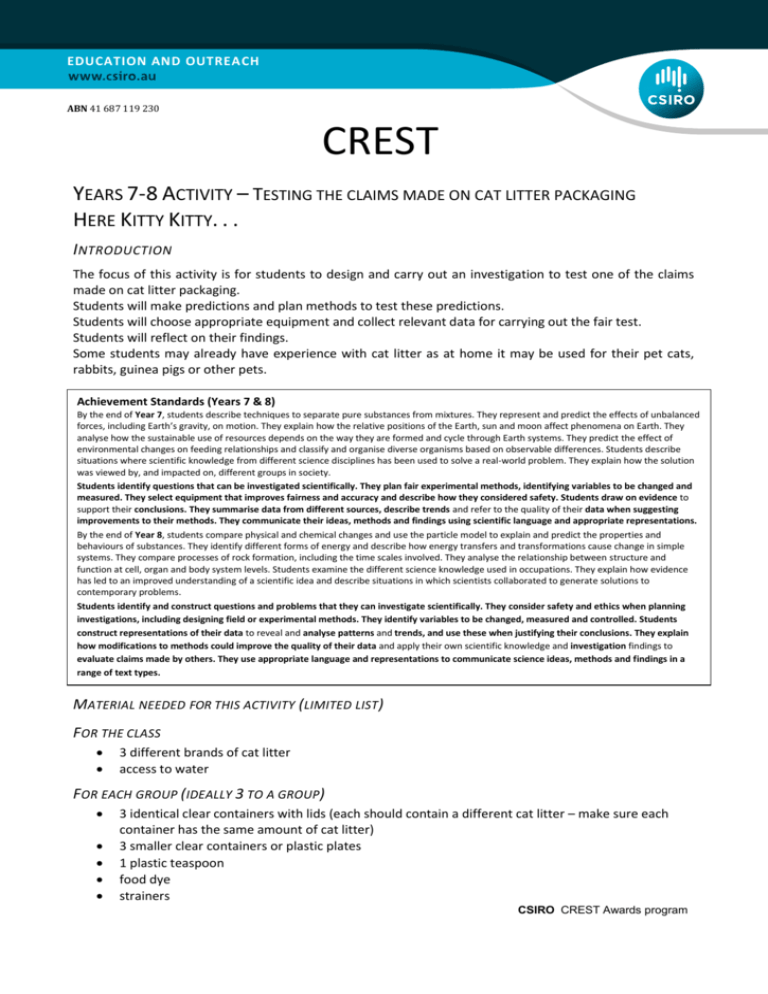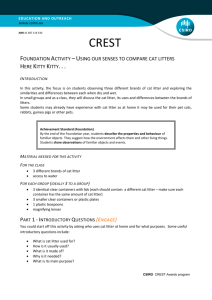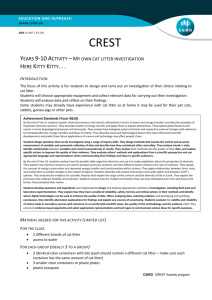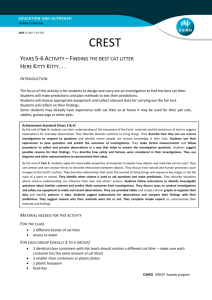Year 7-8 CREST Activity
advertisement

EDUCATION AND OUTREACH EDUCATION AND OUTREACH ABN 41 687 119 230 CREST YEARS 7-8 ACTIVITY – TESTING THE CLAIMS MADE ON CAT LITTER PACKAGING HERE KITTY KITTY. . . I NTRODUCTION The focus of this activity is for students to design and carry out an investigation to test one of the claims made on cat litter packaging. Students will make predictions and plan methods to test these predictions. Students will choose appropriate equipment and collect relevant data for carrying out the fair test. Students will reflect on their findings. Some students may already have experience with cat litter as at home it may be used for their pet cats, rabbits, guinea pigs or other pets. Achievement Standards (Years 7 & 8) By the end of Year 7, students describe techniques to separate pure substances from mixtures. They represent and predict the effects of unbalanced forces, including Earth’s gravity, on motion. They explain how the relative positions of the Earth, sun and moon affect phenomena on Earth. They analyse how the sustainable use of resources depends on the way they are formed and cycle through Earth systems. They predict the effect of environmental changes on feeding relationships and classify and organise diverse organisms based on observable differences. Students describe situations where scientific knowledge from different science disciplines has been used to solve a real-world problem. They explain how the solution was viewed by, and impacted on, different groups in society. Students identify questions that can be investigated scientifically. They plan fair experimental methods, identifying variables to be changed and measured. They select equipment that improves fairness and accuracy and describe how they considered safety. Students draw on evidence to support their conclusions. They summarise data from different sources, describe trends and refer to the quality of their data when suggesting improvements to their methods. They communicate their ideas, methods and findings using scientific language and appropriate representations. By the end of Year 8, students compare physical and chemical changes and use the particle model to explain and predict the properties and behaviours of substances. They identify different forms of energy and describe how energy transfers and transformations cause change in simple systems. They compare processes of rock formation, including the time scales involved. They analyse the relationship between structure and function at cell, organ and body system levels. Students examine the different science knowledge used in occupations. They explain how evidence has led to an improved understanding of a scientific idea and describe situations in which scientists collaborated to generate solutions to contemporary problems. Students identify and construct questions and problems that they can investigate scientifically. They consider safety and ethics when planning investigations, including designing field or experimental methods. They identify variables to be changed, measured and controlled. Students construct representations of their data to reveal and analyse patterns and trends, and use these when justifying their conclusions. They explain how modifications to methods could improve the quality of their data and apply their own scientific knowledge and investigation findings to evaluate claims made by others. They use appropriate language and representations to communicate science ideas, methods and findings in a range of text types. MATERIAL NEEDED FOR THIS ACTIVITY (LIMITED LIST ) FOR THE CLASS 3 different brands of cat litter access to water FOR EACH GROUP (IDEALLY 3 TO A GROUP) 3 identical clear containers with lids (each should contain a different cat litter – make sure each container has the same amount of cat litter) 3 smaller clear containers or plastic plates 1 plastic teaspoon food dye strainers CSIRO CREST Awards program EDUCATION AND OUTREACH EDUCATION AND OUTREACH ABN 41 687 119 230 CREST stopwatch measuring cylinders or medicine cups other materials as requested by students PART 1 - INTRODUCTORY QUESTIONS (ENGAGE) You could start off this activity by asking who uses cat litter at home and for what purposes. Some useful introductory questions include: What is cat litter used for? How is it usually used? What is it made of? Why is it needed? What is its main purpose? Give each group set of three clear containers that contain the different cat litters and let them have a closer look at each of the samples. The advertising on many cat litter packaging make claims about their products. These can include: Superior odour control Highly absorbent Virtually dust free Economical – long lasting Natural fly repellent Biodegradable Give students access to three different packaging of cat litter and let them know how much each brand costs. Some brands have different claims and different properties. Discuss these with the students. Discuss the difference in prices between the three cat litters (if any). Ask the students to think about how they could carry out investigations to test some of the claims made on the packaging. PART 2 – TESTING CLAIMS MADE ON CAT LITTER PACKAGING (EXPLORE, EXPLAIN) For this activity students can work in small groups (maximum of 3) or individually. Students should be familiar with the concepts of fair testing. a) Ask students are to design and carry out an investigation to test one of the claims on the cat litter packaging to see if it is best at that claim. It is up to the students to decide which claim to test and how they are going to test it. Discuss with the students that their specific method to find the ‘best’ at a particular claim may be different from other groups. It is also up to them to decide how they will define ‘best’ in their investigation. They need to be specific about their meaning (eg absorbs most liquid, absorbs liquid the fastest etc). They can use the questions below to assist their planning. CSIRO CREST Awards program EDUCATION AND OUTREACH EDUCATION AND OUTREACH ABN 41 687 119 230 CREST What claim will you be testing? Do you need to research how you could test this property? Where will you look for information to assist you? What will you be measuring? How will you actually measure this? How will you ensure your measurements are accurate? What equipment are you going to use? Is it available? What will results you record? How will you record these? Are there any safety precautions you need to take? List the steps you will do in your investigation. Have you designed a fair test? b) Ask students to provide you with a detailed list of equipment they require for their investigation. If their requests are beyond what you are able to supply ask them to think about what they could use as an alternative or if they could adapt some existing equipment to do the task. If they are still unable to come up with a suitable alternative then they may have to revise their method for their investigation. Students may need some assistance while working through their open-ended investigation. If you are registered for CREST you can use the CREST Science Investigation Planner – Advanced to assist the students. As this activity may require several lessons for students to complete their investigations you will need to consider the storage of their equipment whilst it is being completed. Students are asked to provide you with a detailed list of equipment they require for their investigation. If you have a lab technician available you could ask students to complete the same forms you provide your lab technician when requesting material. If you also include a risk assessment form work with the students to complete one for their investigation. If you are registered for CREST, the CREST Student Handbook – Science contains detailed descriptions of the open investigation process. The Bronze CREST Profile Card also provides a checklist of these key steps. CSIRO CREST Awards program EDUCATION AND OUTREACH EDUCATION AND OUTREACH ABN 41 687 119 230 CREST PART 3 – CLASS PRESENTATION (ELABORATE & EVALUATE) Ask the students to communicate to the rest of the class whether their specific cat litter claim on the packaging was true and how they went about testing this. Have the class critique each presenter’s investigation and how well it was presented to the class. As an extra activity, have students design a creative way to communicate their findings to others. They can use any communication mechanism they wish – booklet, poster, movie, web based etc A SSESSMENT R UBRIC This assessment rubric links is based on the content descriptors of the Science Inquiry Skills strand of the Australian Curriculum: Science It is provided as guide for you to use with the above activity. Please feel free to adapt or develop your own rubric to use with your students. Science Inquiry Skills Questioning and Predicting Planning and Conducting Developing Fails to identify a question about the cat litter that can be investigated scientifically. Fails to make predictions about the outcome of their investigation based on even scientific Struggles with assistance, knowledge.to collaboratively or individually plan and conduct the cat litter investigation ensuring safety and ethical guidelines are followed. Has trouble measuring and controlling variables and selecting equipment to collect data with accuracy. Consolidating With assistance, can Identify a question about the cat litter that can be investigated scientifically and make predictions about the outcome of their investigation With help can, collaboratively or based on scientific individually plans and knowledge. conducts the cat litter investigation ensuring safety and ethical guidelines are followed. Measures and controls variables and selects equipment to collect data with accuracy only with guidance. Achieving Identifies a question about the cat litter that can be investigated scientifically. Makes predictions about the outcome of their investigation based on scientific knowledge. Collaboratively or individually plan and conduct the investigation ensuring safety and ethical guidelines are followed. Measure and control variables and select equipment to collect data with accuracy appropriate to the task. CSIRO CREST Awards program EDUCATION AND OUTREACH EDUCATION AND OUTREACH ABN 41 687 119 230 CREST Processing and Analysing Data and Information Struggles to construct and use a range of representations to represent and analyse patterns or relationships. Has trouble summarising data, from own cat litter investigations and secondary sources, and is unable to use scientific understanding to identify relationships and draw conclusions. Evaluating Requires great assistance to reflect on the method used to investigate the cat litter claim investigation, including limited evaluating of the quality of the data collected, and identifying improvements to the method. Is unable to use scientific knowledge and findings from their investigations to evaluate the claims on the packaging. Communicating Has trouble communicating ideas, findings and solutions to problems using scientific language and representations using digital technologies as appropriate. Requires assistance to construct and use a range of representations, including graphs, keys and models to represent and analyse patterns or relationships, including using digital technologies as appropriate. Summarises data, from own cat litter investigations and secondary sources with help. Uses limited scientific understanding to identify relationships and draw conclusions. Limited reflection on the method used to investigate the cat litter claim investigation, including limited evaluation of the quality of the data collected, and identification of improvements to the method. Uses limited scientific knowledge and findings from their investigations to evaluate the claims on the packaging. With assistance can communicate ideas, findings and solutions to problems using scientific language and representations using digital technologies as appropriate. Constructs and uses a range of representations, including graphs, keys and models to represent and analyse patterns or relationships, including using digital technologies as appropriate. Summarises data, from own cat litter investigations and secondary sources, and uses scientific understanding to identify relationships and draw conclusions. Reflects on the method used to investigate the cat litter claim investigation, including evaluating the quality of the data collected, and identifies improvements to the method Uses scientific knowledge and findings from their investigations to evaluate the cat litter claims on the packaging. Easily communicate ideas, findings and solutions to problems using scientific language and representations using digital technologies as appropriate. CSIRO CREST Awards program EDUCATION AND OUTREACH EDUCATION AND OUTREACH ABN 41 687 119 230 CREST This activity also links to the following in the Australian Curriculum: Science Science as a Human Endeavour Nature and development of science Scientific knowledge changes as new evidence becomes available, and some scientific discoveries have significantly changed people’s understanding of the world. Scientific knowledge can develop through collaboration and connecting ideas across the disciplines of science. CREST Link By completing this activity, students may be eligible to receive a Bronze CREST Award. CREST Science Investigation Planner – Basic. This investigation planner is designed to be used with sticky notes. It helps students identify the variables in their experiment and organise their variables so they can ensure that they are only changing one thing and only measuring one thing. CREST Science Investigation Planner – Intermediate & Advanced. This investigation planner is an extension of the Basic planner above to further assist students throughout the open investigation process. Downloads of both planners can be found at www.csiro.au/crestonline The CREST Student Handbook – Science containing detailed descriptions of each step in the open investigation process as well as the Bronze CREST Profile Card are provided to assist students working at the Bronze CREST Award level. More information about CREST is available at www.csiro.au/crest CSIRO CREST Awards program





